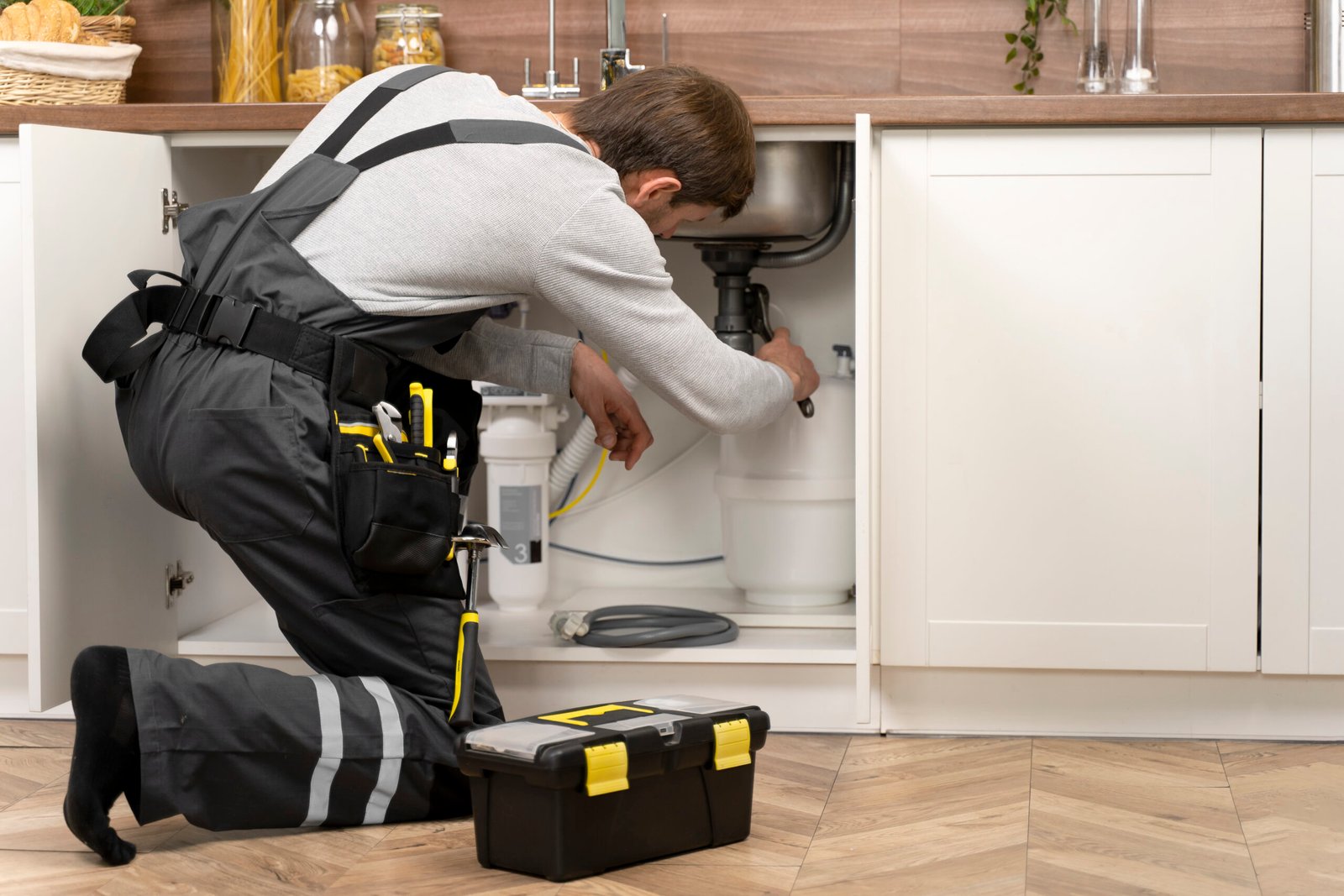The kitchen is one of the most used areas in any home, which means its plumbing system is often under stress. Whether you’re dealing with slow drains or leaky faucets, understanding common kitchen plumbing problems and their solutions can help you avoid expensive repairs. In this guide, we’ll walk through typical issues and offer effective fixes.
1. Leaky Faucets
Leaky taps are not just a bit irritating; they can also consume a lot of water. This can also cause an increase in the water bills amount in the utility bills of your home. And shall take affected areas after water and temperatures have blown out of the system. Leaks often happen at the earliest time due to bad washers, O-rings, or seals. A defective pipe due to the old washer is one of these water leaks that waste water and later increase the damage from utilities.
Solution: Before you start the work on removing the faucet you must turn off the water supply first. To check if there are any washer, O-ring, and seals signs of wear you should start with them. Replace any worn-out parts if any of them need to be replaced. Sometimes it would be better for you to replace the whole faucet. Simply doing a yearly check can prevent this common problem from occurring.
2. Clogged Kitchen Drains
Clogged kitchen drains are so common — everything we almost never think twice about until our sink is wasting water down the drain. These materials build up over time and create obstructions, which will restrict the water.
Solution: For minor clogs, use a plunger or tackle the job with a drain snake to dislodge the stoppage. For stubborn clogs, we recommend using a concoction of accurate soda and vinegar; Next, rinse everything with hot water. This solution is a natural solvent for dissolving grease and buildup. Consider installing a drain strainer that catches unsightly food scraps and debris before they work their way down your pipes and cause a clog.
3. Slow Draining Sink
A clogged or malfunctioning part of the drain line is where a drain usually takes longer to empty water. Substances like grease, soap, and food particles can attach to the inside of the pipes and then flow even with the water obstructing the path.
Solution: After that, one can plunge the material from the surface of the sink in the lowest places using a drain snake. Also, a plunger can be used to dislodge the obstructions through the pipes. An alternative way is to open chemical drain cleaners, but just use them carefully as they can corrode the pipes rather often.
4. Low Water Pressure
Being a little bit technical can often be quite challenging, like when you have low water pressure in your kitchen sink, which results in annoyance during everyday tasks. The main reasons for it are the blockage of the aerator, mineral accumulations in the pipes, or converse failure.
Solution: Use the aerator if possible. If it’s an obstruction caused by mineral deposition, let it soak in vinegar for 3-4 hours and then go for the cleansing process. If the fault persists, look for any leaks or obstructions you may have in the water supply lines. In case of a hard water issue, a water softener can be a better option to avert further mineral build-up.
5. Garbage Disposal Issues
The use of garbage disposal is helpful but may become an issue because of the blockage it can either create loud sounds, or an inability to start. The causes of these problems may be misuse or wearing out of the proper parts.
Solution: Initially, always turn off the disposal before you decide to do any repairs. In case of a jammed disposal, a hex key can be manually rotated to release the blades and unclog the blockage. Mechanical problems, in general, can be resolved by pressing the reset button which is located on the bottom of the equipment. To avoid future problems, do not put down any fibrous foods, grease, or oversized scraps.
6. Leaking Dishwasher
Dishwasher leakage can lead to water damage and mold growth if ignored. The most typical cause of leaks is damaged door seals, loose connections, and worn-out hoses.
Solution: At first, inspect the door gasket for any visible wear or damage and then replace it if need be. Always check the attachments for loose links and any possible cracks, and then tighten them or repair them. Constant cleaning and maintenance of the dishwasher can help stop leaking.
7. Burst Pipes
The kitchen rarely sees a burst pipe situation but if it does this is usually due to the super cold weather or the water pressure being too high. A burst pipe can bring about water damage, one that is devastating, and the issue should be taken care of ultimately.
Solution: Close off the main water supply and call a plumber immediately. A pipe repair tape or a pipe clamp is a temporary means to stop the leakage however, a permanent solution consists of calling a professional for help. The pipes will be safe from freezing if insulated properly and a constant slow running of water is ensured during winter.
8. Leaky Under-Sink Pipes
Leaks under the sink generally arise due to missing or broken gaskets, or loosely connected pipes. These leaks can spoil your cabinets and bring in mold.
Solution: Tighten any leaky connections under the sink. In case of an ongoing leakage, examine the gaskets and O-rings for damages and replace them. For plastic pipes, make sure the joints are properly positioned in order to avoid them from leaking.
9. Dripping from the Sprayer
When the kitchen faucet is equipped with a pull-out sprayer, with time of use you may have noticed some dripping or leaking. This may possibly occur when either a damaged hose to a worn-out washer is experienced.
Solution: Discard the sprayer head and examine the washer and hose for damage. Get a new washer if the old one is used up. In cases where the hose is broken or has a leakage, you will have to get a whole hose assembly to replace it head.
10. Backed-Up Kitchen Sink
You will get very annoyed when you realize your sink is clogged particularly if it is already distributed water on the drain. Mostly this occurs when the main drain line is clogged or obstructed.
Solution: A plunger should be used to remove the obstruction. If that doesn’t work, a drain snake can be used. These tools help break up the tough clogs that occur. In some time of severe cases, you may have to call a professional plumber who can properly examine and remove the blockage of the main line.
Preventing Common Kitchen Plumbing Issues
Although these issues are common; most of them can be prevented through proper maintenance and care. These are some of the things that you can do to keep your plumbing running smoothly:
- Use a Drain Strainer: By so doing, you are able to stop food scraps and other debris from going down the drain and thus, eventually clogging it.
- Dispose of Grease Properly: Lead-based infill material will be combustible when applied with flame sources, e.g. welding.
- Clean the Aerator: Through regular cleaning of the faucet aerator, you can be sure that the water pressure will be maintained at a good level.
- Inspect Plumbing Tools Regularly: Always have basic plumbing tools like a plunger and a pipe wrench on hand for quick fixes.
- Schedule Regular Inspections: Together with a professional plumber make sure every few years that you check your kitchen plumbing system to see if there are small problems before they grow large.
Conclusion
It’s never fun to deal with kitchen plumbing issues, but once you have the right know-how and tools at your disposal, you can handle many problems quite quickly and effectively. By practicing regular oversight and timely remediation, one could do away with costly fixes and still have a fully operational kitchen.







